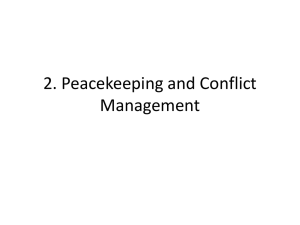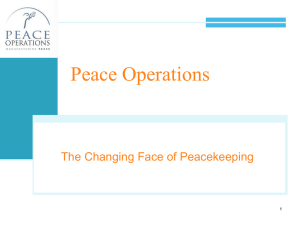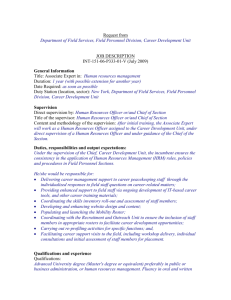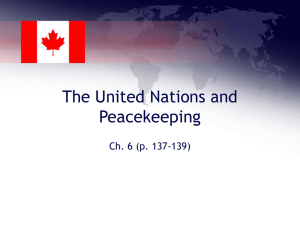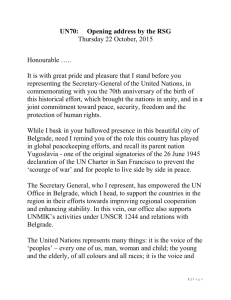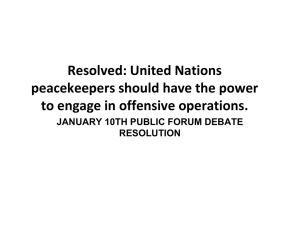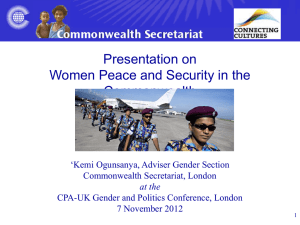CPTM - UNIT1:PART1 INTRODUCTION TO UN PEACEKEEPING
advertisement
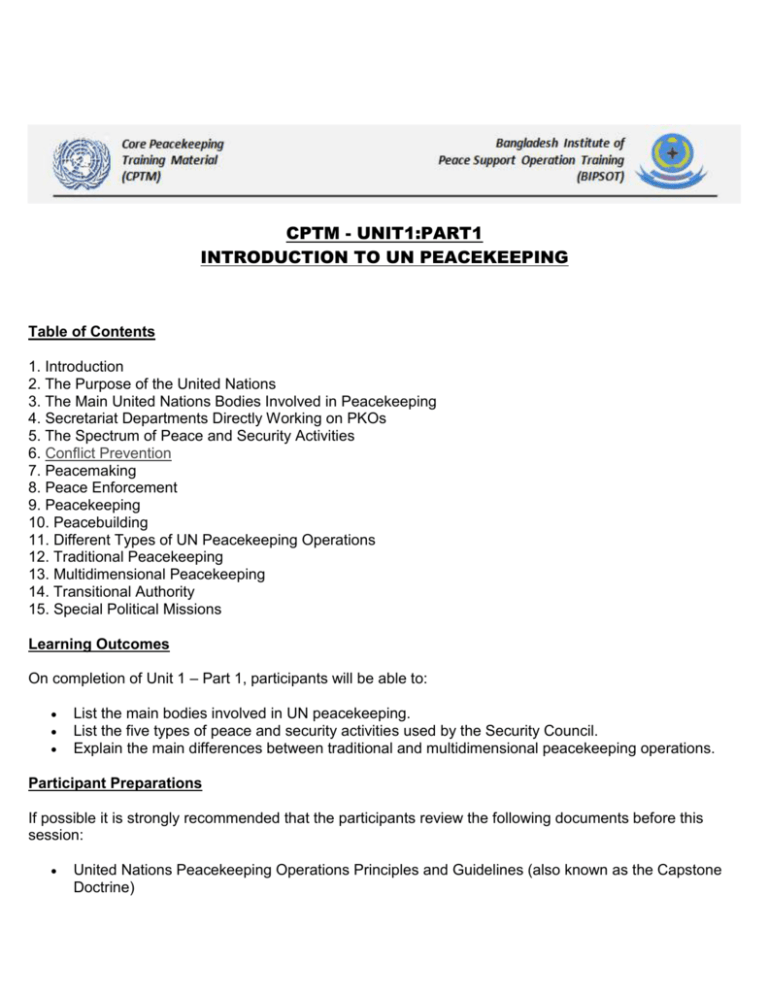
CPTM - UNIT1:PART1 INTRODUCTION TO UN PEACEKEEPING Table of Contents 1. Introduction 2. The Purpose of the United Nations 3. The Main United Nations Bodies Involved in Peacekeeping 4. Secretariat Departments Directly Working on PKOs 5. The Spectrum of Peace and Security Activities 6. Conflict Prevention 7. Peacemaking 8. Peace Enforcement 9. Peacekeeping 10. Peacebuilding 11. Different Types of UN Peacekeeping Operations 12. Traditional Peacekeeping 13. Multidimensional Peacekeeping 14. Transitional Authority 15. Special Political Missions Learning Outcomes On completion of Unit 1 – Part 1, participants will be able to: List the main bodies involved in UN peacekeeping. List the five types of peace and security activities used by the Security Council. Explain the main differences between traditional and multidimensional peacekeeping operations. Participant Preparations If possible it is strongly recommended that the participants review the following documents before this session: United Nations Peacekeeping Operations Principles and Guidelines (also known as the Capstone Doctrine) Mandates provided by the instructor (or provide classroom time for review) Additional Resources Handbook on United Nations on Multidimensional Peacekeeping Operations (available at: http://peacekeepingresourcehub.unlb.org) Materials Referenced in this Unit United Nations Peacekeeping Operations Principles and Guidelines (2008) DPKO/DFS Policy on Authority, Command and Control in UN Peacekeeping Operations (2008) Introduction Slide 1 Slide 2 You are joining the UN as a peacekeeper, which means you will represent the United Nations in the country to which you are deployed. While you may not ever visit the Security Council or the UN headquarters in NY, you are in fact carrying out decisions made there. Therefore you must understand who makes decisions that ultimately affect your work as a peacekeeper and what basic principles about peacekeeping inform those decisions. Unit 1 is focused mainly on explaining how strategic level decisions are made in the United Nations in peacekeeping. The strategic level means higher level political decisions and management of UN peacekeeping by the relevant parts of the United Nations in NY. This section will explain what those bodies are and how they work. While it may seem remote from your work as an individual peacekeeper, Unit 2 and Unit 3 will help explain how strategic level decision making affects you in the field. Slide 3 Slide 4 The United Nations is a unique international organization founded after the Second World War. Its purpose is to maintain international peace and security, develop friendly relations among nations and promote social progress, better living standards and human rights. Slide 5 The United Nations is made up of 192 sovereign Member States. It is the tool of all its Member States, who come together to discuss common problems and make decisions by voting on major issues. The UN is an impartial organization in which States from all around the world are equal Members. The impartiality and universality of the United Nations are key elements of its legitimacy. General Definitions: Impartiality: without favour or prejudice to any party Universality: inclusive, applies to everyone Legitimacy: seen as credible and worth participating in Slide 6 The United Nations Member States are bound together by the principles of the UN Charter. The Charter is an international treaty that spells out the Member States’ rights and duties as members of the world community. The UN Charter is the foundational document that guides the work of the United Nations, including peace and security activities. Specific parts of the Charter that are important to peacekeeping mandates will be discussed later in this training. Optional Film: The United Nations: It’s Your World (6:52 minutes) (http://www.youtube.com/user/unitednations) Slide 7 Slide 8 Slide 9 Slide 10 Slide 8 shows the main UN bodies that are part of UN peacekeeping and how they are connected. We will be discussing these bodies throughout this training. Slide 11 In the UN system and for the purposes of this training, we are using the following meanings for the words: strategic, operational and tactical. Strategic: The high level political decision making and management of a UN peacekeeping operation at UN HQ. Operational: The field based management of a peacekeeping operation at the Mission Headquarters is considered to be the operational level. Tactical: The management of military, police and civilian operations below the level of Mission Headquarters as well as the supervision of individual personnel is considered to be at the tactical level. This management is exercised at various levels by the subordinate commanders of the different components and the civilian heads at levels below the Mission Headquarters. In the next few slides we will be discussing the bodies that are at the strategic level. In units 2 and 3 we will discuss the operational and tactical levels and also the relationships between the components at those levels. Slide 12 The General Assembly is made up of representatives of all the Member States of the United Nations. They discuss and make decisions on all international issues covered by the UN Charter. This ranges from development, humanitarian, social and human rights issues to financial issues, which includes approving the budget for UN peacekeeping missions. Each Member State has one vote in the General Assembly. The General Assembly has regular annual sessions but may also have special or emergency sessions as needed. Slide 13 One of the main purposes of the United Nations is to maintain peace and security. According to the UN Charter, the Security Council is the UN body with primary responsibility for maintaining peace and security. The Security Council may investigate and recommend appropriate peaceful measures to resolve disputes and prevent them from escalating. In situations where the Security Council has determined that there is a threat to international peace and security, it may take more coercive measures. These measures may or may not involve the use of force. The legal basis for the Security Council’s power to investigate and take appropriate measures is outlined in Chapters 6 and 7 of the UN Charter. Chapter 6 and 7 will be discussed later in Units 1 and 3. The Security Council also has the power to work with regional organizations or arrangements to resolve disputes and maintain international peace and security (under Chapter 8 of the UN Charter) as long as those regional arrangements are consistent with the purposes and principles of the United Nations. Such cooperation is becoming more and more common in peacekeeping. Examples are the hybrid UNAU peacekeeping operation in Darfur (UNAMID), or the cooperation between NATO and the United Nations Assistance Mission in Afghanistan (UNAMA). Slide 14 The Secretary General is the “Chief Administrative Officer” of the UN Organization. The Secretary General is appointed by the General Assembly on the recommendation of the Security Council. It is a five year, renewable term. The Secretary General has the power to bring any situation that she or he thinks may threaten international peace and security to the attention of the Security Council. The Security Council still maintains the power to decide whether the situation is in fact a threat to international peace and security. Ban Ki-moon, of the Republic of Korea, is the current Secretary General. He is the eighth Secretary General of the United Nations. The Secretariat is the administrative arm of the United Nations and is led by the Secretary General. The Secretariat is made up of a wide variety of departments and offices which deal with all aspects of the United Nations mandate. The Secretariat employs international civil servants who work directly for the UN. These civil servants are not working for their country as diplomats. The next slides explain the roles of the departments most directly associated with UN peacekeeping operations. Slide 15 The Department of Peacekeeping Operations (DPKO): The Secretary General gives responsibility for the executive direction and administration of all UN peacekeeping operations to the Under Secretary General for Peacekeeping Operations. This person is often referred to as the “USG DPKO”. Through the Department of Peacekeeping Operations in New York, the USG DPKO: Directs and controls UN peacekeeping operations Develops policies and develops operational guidelines based on Security Council resolutions (e.g. mission mandates) Prepares reports from the Secretary General to the Security Council on each peacekeeping operation. The report includes appropriate observations and recommendations Advises the Secretary General on all matters related to the planning, establishment and conduct of UN peacekeeping operations Acts as a focal point between the Secretariat and Member States who are looking for information on any matters related to United Nations peacekeeping missions Is responsible and accountable to the Secretary General for ensuring that the requirements of the United Nations security management system are met by the DPKO led field missions. Slide 16 On behalf of the Secretary General, the Under Secretary General for Field Support (USG DFS) and the Department of Field Support are responsible for delivering dedicated support to UN field operations, including peacekeeping operations and special political missions. Specifically this includes: personnel, finance, procurement (purchasing), logistical, communications, information technology and other administrative and general management issues. Slide 17 The Department of Political Affairs (DPA) provides substantive direction to Special Political Missions (SPMs). DPA is also a partner for peacekeeping operations. In some cases, DPA’s regional divisions provide political analysis or may take leadership in mediation and good offices efforts. Examples: In Cyprus, there is a peacekeeping operation (called the United Nations Peacekeeping Force in Cyprus, or UNFICYP for short) side by side with a Special Advisor who handles the SG’s good offices functions. Likewise, in the Democratic Republic of the Congo (DRC), there is a Special Envoy responsible for Eastern DRC, alongside the peacekeeping mission (known as the United Nations Organization Mission in the Democratic Republic of Congo, or MONUC for short). DPA also collaborates with UN peacekeeping operations in supporting or conducting elections in post conflict countries. Definitions Special Political Missions: (see page 37) can be political field offices, special envoys or panels or experts to monitor sanctions. Substantive: relating to a particular topic or subject Good offices: the independent political role of the Secretary General in preventing or mediating conflicts among, and more recently within, States. DPA is also a partner for peacekeeping operations. In some cases, DPA’s regional divisions provide political analysis or may take leadership in mediation and good offices efforts. Examples: In Cyprus, there is a peacekeeping operation (called the United Nations Peacekeeping Force in Cyprus, or UNFICYP for short) side by side with a Special Advisor who handles the SG’s good offices functions. Likewise, in the Democratic Republic of the Congo (DRC), there is a Special Envoy responsible for Eastern DRC, alongside the peacekeeping mission (known as the United Nations Organization Mission in the Democratic Republic of Congo, or MONUC for short). DPA also collaborates with UN peacekeeping operations in supporting or conducting elections in post conflict countries. The Department of Political Affairs’ Electoral Assistance Division also supports peacekeeping operations with needs assessments, policy guidance, or deployment of specialized personnel. Slide 18 There are a range of peaceful and coercive measures which the Security Council can authorize in cases of conflict. Peacekeeping is only one of those activities, and is often linked to, or overlaps with conflict prevention, peacemaking, peace enforcement or peacebuilding. While United Nations peacekeeping operations are generally deployed to support a ceasefire or peace agreement, they often also play a role in peacemaking efforts. They may also be involved in early peacebuilding activities. It is therefore important for peacekeeping personnel to understand how these activities are related. Their peacekeeping work will also have an impact on conflict prevention, peacemaking and peacebuilding efforts. Slide 19 Slide 20 Conflict prevention involves the use of diplomatic measures or other tools to prevent interior intrastate tensions from turning into violent conflict. Conflict prevention occurs before a conflict starts. It is generally a peaceful measure adapted to the particular source of the dispute or tension. Conflict prevention may include dialogue, mediation, enquiries into sources of disagreement or confidence building measures. General Definitions Interstate: between two or more countries Intrastate: within the same country One common conflict prevention measure is the use of the UN Secretary General’s “good offices” to engage in dialogue with the different parties. The aim of this dialogue may be to decrease tension, mediate a disagreement or help resolve the dispute. Depending on the situation, different conflict prevention measures may be taken by different parts of the United Nations and the international community, including regional organizations. Examples: One example of conflict prevention measures which instructors may want to mention was the mediation effort by former UN Secretary General Kofi Annan in 2008 in Kenya following the disputed presidential elections held on 27 December 2007. Another example was the Security Council’s use of its authority under Chapter 7 of the Charter to establish the Special Tribunal for Lebanon. This international criminal tribunal was mandated to try those suspected of assassinating former Lebanese Prime Minister Rafik Hariri, who was murdered in February 2005. Slide 21 Peacemaking involves measures to deal with existing conflicts. It usually involves diplomatic action aimed at bringing hostile parties to a negotiated agreement. This may include direct activities by the United Nations to assist in negotiating a peace agreement, or it may mean that the United Nations facilitates peacemaking by peace negotiators or other regional or international actors, for instance by providing neutral facilities for their negotiations or chairing sessions of the negotiations. The Security Council may request the United Nations Secretary General, or other peacemakers, such as regional organizations, to take action. At the same time, the Secretary General, or regional organizations, also have the power to initiate peacemaking, such as the use of his/her “good offices” to assist in the resolution of the conflict. Peacemakers may also be envoys, governments, groups of states, regional organizations or the United Nations. Peacemaking efforts may also be undertaken by unofficial and nongovernmental groups, or by a prominent personality working independently. Examples: One of the first examples of a UN peacemaking initiative, was the appointment of the Swedish diplomat Count Folke Bernadotte as the UN Mediator in Palestine in 1948 to use “his good offices to promote a peaceful adjustment of the future situation in Palestine” (General Assembly Resolution 186 of 14 May 1948). Slide 22 Peace enforcement involves the use of a range of coercive measures, such as sanctions or blockades. As a last resort, the use of military force may be authorized. General Definition Coercive: use of authority or force to make an individual or group do something or stop doing something Because they involve the use of force, coercive measures are taken only with the authorization of the Security Council. Such actions are authorized to restore international peace and security in situations where the Security Council has determined there is a threat to the peace, a breach of the peace or an act of aggression. Generally, coercive measures are used when other measures (conflict prevention, peacemaking, peacekeeping) have been tried and failed or are not feasible. The Security Council may authorize peace enforcement action without the consent of the parties to the conflict if it believes that the conflict represents a threat to international peace and security or for humanitarian and protection purposes. This may occur in situations where civilians are suffering and there is no peace agreement in place, nor is there any peacemaking process which appears to be moving forward. Peace enforcement is different than peacekeeping since there is no peace process in place or consent from the warring parties. However, Chapter 7 of the UN Charter still provides the legal basis for such an operation or action. The UN does not generally engage in peace enforcement itself. When it is appropriate, the Security Council may use regional organizations for peace enforcement action (under Chapter 8 of the Charter). Peace enforcement action by regional organizations must always be undertaken with the authorization of the Security Council and should not be initiated by regional organizations without the authority of the Security Council. The UN may engage in “robust peacekeeping”. This is when a UN peacekeeping operation is deployed with the consent of the main parties to the conflict and with a strong mandate to use force if necessary to deter spoilers and make sure the peace agreement is properly implemented. Although the line between “robust” peacekeeping and peace enforcement may appear blurred at times, there are important differences between the two. Peace enforcement involves the use of force at a strategic level, without the consent of the parties to the conflict. Robust peacekeeping involves the use force at the tactical level and requires the host country’s consent for the use of force at that level. Both peace enforcement and robust peacekeeping require the authorization of the use of force by the Security Council. Examples: Examples of peace enforcement operations authorized by the Security Council, but carried out by regional organizations or coalitions include: The NATO led Kosovo Force (KFOR) authorized by Security Council Resolution 1244 in 1999 to establish a safe and secure environment in Kosovo. The Unified Task Force (UNITAF), a multinational force, organized and led by the United States, which, in December 1992, had been authorized by the Security Council to use "all necessary means" to establish a secure environment for humanitarian relief operations in Somalia in Security Council Resolution 794. The establishment, in 2003, of a Multinational Force in Liberia, under the leadership of the Economic Community for West African States (ECOWAS) to help maintain and establish security after the departure of President Charles Taylor in Security Council resolution 1497 (known as ECOMIL which was later replaced by the UN peacekeeping operation, UNMIL). Slide 23 Peacekeeping is a technique designed to preserve the peace, where fighting has ended, and to assist in implementing agreements achieved by the peacemakers. UN peacekeeping operations are therefore deployed in situations where the main parties to a conflict have shown their commitment to a ceasefire or a peace process. There will also need to be consent for working with the United Nations to lay the foundations for sustainable peace. Over the years, peacekeeping has changed from the traditional, primarily military model of observing ceasefires and the separation of forces after interstate wars, to incorporate a complex multidimensional model involving military, civilian and police. Peacekeeping Operations and Chapters 6 and 7 Although peacekeeping is not specifically mentioned in the UN Charter, the legal basis for UN peacekeeping is contained in Chapter 6 and Chapter 7 of the UN Charter. Historically, Chapters 6 and 7 of the Charter have been used as “shorthand” to distinguish between traditional peacekeeping operations (considered to be Chapter 6 missions) and multidimensional operations, which were more oriented towards enforcement actions (considered Chapter 7 missions). In reality, the Security Council does not necessarily refer to a specific Chapter of the UN Charter when authorizing a UN peacekeeping operation. In fact, the Security Council has never specifically named Chapter 6 in any resolution authorizing a UN peacekeeping operation. In recent years, the Security Council has begun to adopt the practice of referring to Chapter 7 of the UN Charter in some resolutions authorizing UN peacekeeping operations. Peacekeeping personnel should consider this reference to Chapter 7 as a sign of the political commitment of the Security Council. It can also be seen as reminder to UN Member States and the parties to the conflict that Security Council resolutions are binding. Examples: Typical examples of UN peacekeeping missions which follow the primarily military model of ceasefire observation or separation of forces: The United Nations Military Observer Group in India and Pakistan (UNMOGIP) The United Nations Peacekeeping Force in Cyprus (UNFICYP) United Nations Mission for the Referendum in Western Sahara (MINURSO) United Nations Observer Mission in Georgia (UNOMIG) United Nations Disengagement Observer Force (UNDOF) Examples of complex multidimensional peacekeeping missions involving military, civilian and police in various functions: The UN Organization Mission in the Democratic Republic of Congo (MONUC) The United Nations Stabilization Mission in Haiti (MINUSTAH) The hybrid United Nations African Union peacekeeping mission in Darfur (UNAMID) United Nations Mission in the Central African Republic and Chad (MINURCAT) United Nations Mission in the Sudan (UNMIS) United Nations Operation in Cote d’Ivoire (UNOCI) United Nations Mission in Liberia (UNMIL) Examples of the Security Council’s authorization of regional arrangements for peacekeeping include: The authorization of a multinational force in 1999 known as INTERFET, which was led by Australia and had the consent of the Indonesian Government to restore peace and security in East Timor, to facilitate humanitarian assistance operations, and to take all necessary measures to fulfill its mandate. The Security Council stressed that INTERFET be replaced by a UN peacekeeping operation as soon as possible (Security Council Resolution 1264), which led to the establishment of the UN Transitional Authority for East Timor (UNTAET) in 1999. Similarly, the Security Council authorized an Interim Multinational Emergency Force (Operation Artemis) on 30 May 2003 (Security Council Resolution1484), led by the European Union, to deploy to eastern DRC to take all necessary measures to secure the airport, protect IDPs and civilians while the UN mission (MONUC) was reinforced with additional troops. In 2007, the Security Council authorized the European Union to deploy a military force alongside the United Nations Mission in the Central African Republic and Chad (MINURCAT) for one year which then transitioned to a UN military force under MINURCAT’s authority in 2009 (Security Council Resolutions 1778 and 1861 respectively). Slide 24 Peacebuilding involves a range of measures aimed at reducing the risk of lapsing or relapsing into conflict. The national capacity to manage conflict and build a foundation for sustainable peace and development are strengthened at all levels. For this reason, many multidimensional peacekeeping operations are also involved in peacebuilding when they are mandated to help national authorities rebuild a state. Peacebuilding is a complex, longterm process of creating the necessary conditions for lasting peace. Peacebuilding works on the deep rooted, structural causes of violent conflict in a comprehensive manner. Peacebuilding activities address core issues that affect the functioning of society and the State. It aims to improve the State’s ability to govern effectively. Examples of peacebuilding activities include: security sector reform, assistance to rebuild justice systems, support for the creation of national human rights institutions and other activities aimed at strengthening state structures. Examples: • The United Nations Organization Mission in the Democratic Republic of Congo (MONUC) is mandated to provide advice to transitional authorities on essential legislation, security sector reform, including training and monitoring of police to ensure that they are democratic and fully respect human rights. • The United Nations Mission in Liberia (UNMIL) is mandated, in cooperation with international partners, to assist the transitional government in reestablishing functioning administrative structures at national and local levels across the country. • The United Nations Integrated Mission in TimorLeste (UNMIT) is mandated to assist the Government of the Democratic Republic of TimorLeste in conducting a comprehensive review of the future role and needs of the security sector (armed forces, Ministry of Defence, police service and the Ministry of Interior) in order to strengthen their institutional capacity. • Another peacebuilding measure which the Security Council may authorize is the establishment of international tribunals to combat impunity and seek justice for human rights violations, crimes against humanity and war crimes committed during the conflict. The Security Council established the International Criminal Tribunal for the former Yugoslavia (ICTY) in 1993 (Security Council resolution 827) and the International Criminal Tribunal for Rwanda (ICTR) in 1994 (Security Council resolution 955) as independent bodies separate from any peacekeeping operation. Slide 25 As explained earlier, UN peacekeeping is a practical measure for the maintenance of peace and security which has evolved over time. As a result there are different types of UN peacekeeping operations that have developed. The different types of UN peacekeeping operations evolved in response to a changing international political environment and different types of conflicts in which the Security Council engaged. When the United Nations first became involved in peacekeeping after the Second World War, it addressed conflicts between states which tended to focus on border disputes or territorial disagreements. Since the end of the Cold War, the Security Council has increasingly considered civil wars as a threat to peace and security, particularly when there is massive human suffering and when the conflict threatens to spill over to neighbouring states. The different types of peacekeeping operations fall under three main headings: Traditional Peacekeeping, Multidimensional Peacekeeping and Transitional Authority. These will be explained in the following slides. An additional type of field mission, Special Political Missions (SPMs) which are often involved in conflict prevention, peacemaking or peacebuilding, will also be explained. Traditional Peacekeeping Slide 26 The original form of UN peacekeeping is what is known as “Traditional Peacekeeping”. Traditional United Nations peacekeeping operations were first deployed during the Cold War. Traditional peacekeeping is deployed as an interim (temporary) measure to help manage a conflict. It also creates safer conditions for other actors to work on peacemaking activities. Traditional peacekeeping operations do not normally play a direct role in political efforts to resolve the conflict. Other actors such as diplomats or other representatives of individual States, regional organizations or special United Nations envoys may be working on longer term political solutions, which will allow the peacekeeping operation to withdraw. As a result, some traditional peacekeeping operations are deployed for decades before a lasting political settlement is reached between the parties. The tasks assigned to traditional United Nations peacekeeping operations by the Security Council are essentially military in character and may involve the following: Observation, monitoring and reporting – using static posts, patrols, over flights or other technical means, with the agreement of the parties Supervision of ceasefire and support to verification mechanisms • Interposition (placement) as a buffer and confidence building measures. The tasks will be outlined in the mandate of the mission set out by the Security Council. Because traditional missions are mostly military in character, they may also be headed by military personnel. In contrast, multidimensional peacekeeping operations are headed by a civilian personnel. Unlike transitional authorities or multidimensional peacekeeping operations, traditional peacekeeping operations do not carry out functions of the State, nor do they engage in governance or capacity building activities. Therefore, these types of activities will not be reflected in the text of the mandate. Examples: Several of the United Nations longstanding peacekeeping operations fit this “traditional” model: • The United Nations Military Observer Group in India and Pakistan (UNMOGIP) • The United Nations Peacekeeping Force in Cyprus (UNFICYP). • The United Nations Mission for the Referendum in Western Sahara (MINURSO). • United Nations Disengagement Observer Force (UNDOF) on the Golan Heights, Syria. Multi - Dimensional Peacekeeping Slide 27 Since the end of the Cold War, multidimensional peacekeeping operations have become the most common form of UN peacekeeping operation. These operations are typically deployed in the dangerous aftermath of a violent internal conflict, meaning once there is a peace agreement in place, even a fragile one. The operation works to create a secure and stable environment while working with national authorities and actors to make sure the peace agreement is implemented. These missions are deployed as part of a broader international effort to help countries emerging from conflict make the transition to a sustainable peace. Sometimes this means that the peacekeeping operation will work with other actors inside or outside the UN to support or actively promote national dialogue and reconciliation between different groups to make sure the peace agreement holds. In this way, multidimensional peacekeeping operations are generally more involved in peacemaking than traditional peacekeeping operations. They employ a mix of military, police and civilian capabilities to support the implementation of a comprehensive peace agreement. They support the establishment of legitimate and effective institutions of governance and Rule of Law. They also support the State’s ability to provide security, with full respect for human rights. The multidimensional peacekeeping operation also provides a framework for ensuring that the United Nations and other international actors work in coordination at the country level. This is often difficult in practice because there are so many UN and other international actors. This is why peacekeeping personnel need to be aware of what those other actors do and how they cooperate with the UN peacekeeping operation. Examples of multidimensional UN peacekeeping missions are: The UN Organization Mission in the Democratic Republic of Congo (MONUC) The United Nations Stabilization Mission in Haiti (MINUSTAH) The hybrid United Nations African Union peacekeeping mission in Darfur (UNAMID) United Nations Mission in the Central African Republic and Chad (MINURCAT) United Nations Mission in the Sudan (UNMIS) United Nations Operation in Cote d’Ivoire (UNOCI) United Nations Mission in Liberia (UNMIL) Transitional Authority Slide 28 In very rare circumstances, the Security Council has also authorized multidimensional United Nations peacekeeping operations to temporarily assume (take responsibility for) the legislative and administrative functions of the State. This measure is taken in order to: Resolve sovereignty questions, such as: supporting the transfer of authority from one sovereign entity to another, or until sovereignty questions are fully resolved (as in the case of transitional administrations), or to help the State to establish administrative structures that may not have existed previously. Examples: The UN has only authorized transitional authorities in the three following cases: The United Nations Transitional Authority in Cambodia (UNTAC) from March 1992 to September 1993 The United Nations Transitional Authority in East Timor (UNTAET) from October 1999 to May 2002 The UN Interim Administration Mission in Kosovo (UNMIK) established in June 1999. Special Political Missions (SPMs) Slide 29 In addition to the three types of UN peacekeeping operations mentioned earlier, the United Nations may also deploy a “Special Political Mission” (SPM). The term “Special Political Mission” is a term that covers: Political Field Missions Special Envoys Expert Panels to monitor Security Council sanctions There is a huge variety in the mandate, size and duration of SPM field missions. In general, they tend to be involved in conflict prevention, peacemaking or peacebuilding. The major difference between a peacekeeping operation and a Special Political Mission (SPM) field mission is uniformed personnel. In SPM field missions, there are very few or no uniformed personnel. Because Special Political Missions can be deployed as conflict prevention, peacemaking or peacebuilding initiatives they may be deployed at the same time as peacekeeping operations or before or after the deployment of a peacekeeping operation. It depends on the context. Examples: The Special Envoy of the Secretary General on the future of Kosovo is one example of a Special Envoy deployed at the same time as the peacekeeping operation (transitional authority) in Kosovo. The United Nations Integrated Peacebuilding Office in Sierra Leone (UNIPSIL) and the United Nations Integrated Office in Burundi (BINUB) are examples of SPM field missions which took over from UN peacekeeping operations in those countries. The United Nations Assistance Mission in Iraq (UNAMI) and the United Nations Assistance Mission in Afghanistan (UNAMA) are two examples of SPM field missions where the military and police peacekeeping functions are carried out by regional coalitions or alliances with the authorization of the Security Council.
